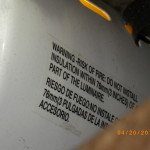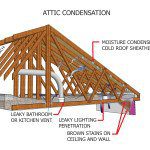6 and a Half things You Probably Didn’t Know About Your Plumbing System

1b. The water seals can evaporate. If you have a bathroom that you don’t use frequently, a floor drain that hardly gets used, or a drain that only gets used during certain times of the year, the water seal in the trap can evaporate. This of course allows the sewer gasses into your home. If any of these scenarios exist in your home, we recommend having a qualified plumber install a trap primer, that will automatically refill the water seal. Alternatively, you could set yourself a reminder to fill the trap with water, or pour mineral oil into the trap that reduces the chance for evaporation.
2. Those white pipes sticking out of your roof are plumbing vents. You know that thing you with your straw? You know…when you put your straw in your drink, place your finger on top, pull the straw out of the drink and watch in amazement as the soda stays in the straw. Releasing your finger allows air into the straw and the soda flows back into the cup. The plumbing vents on your roof allow air into your plumbing system so the water can flow into the sewer pipes. Without them, water and waste would drain slowly. They also allow the noxious sewer gasses a place to escape since you are trapping them at your fixtures.
3. Water heaters are not maintenance free. A lot of home owners put off maintenance and service calls for their equipment, but they are usually aware that its needed. Most home owners seem to be unaware that their water heaters need regular service as well. The tanks can fill with sediment, the anode rods will corrode and deteriorate, one of the elements could be burned out, and the TPRV might not be functional. Having yearly inspection and cleaning from a qualified plumber can keep the water heater running efficiently and prolong its life.
4. There is a lot of money to be saved at your toilet. Older inefficient toilets generally use between 3-5 gallons per flush, with some as high as 7 gallons. The EPA estimates that flushing toilets accounts for almost a third of all residential water use. Upgrading your toilet to a high efficiency watersense toilet can save you more $2000 over the life of the toilet. Personally, I recommend dual flush toilets that save water by allowing you to flush less water when you only have liquid waste.
5. There is no such thing as a hot water heater. Despite popular belief, they aren’t actually called hot water heaters. It’s just a water heater. I am not sure why anyone would want to heat hot water.
6. Plumbing is an art. Sadly, an unfortunate stereotype of plumbers has been ingrained in us, and “plumbers crack” jokes are all too common. At the origins of the plumbing industry, people respected the idea that plumbers were protecting the health of the nation. Plumbing is an art, and properly draining waste, protecting homes from noxious gasses, and providing adequate plumbing ventilation is a refined skill. There are enough plumbers to perpetuate the new stereotype, but qualified professional plumbers do exist. We always recommend Robinson’s Plumbing .


